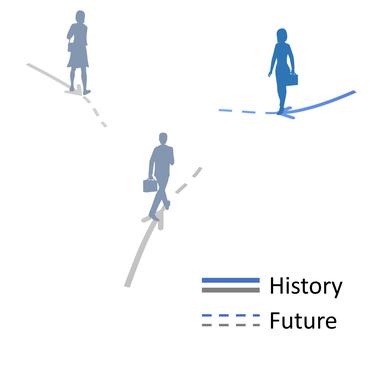Trajectory Prediction
251 papers with code • 29 benchmarks • 34 datasets
Trajectory Prediction is the problem of predicting the short-term (1-3 seconds) and long-term (3-5 seconds) spatial coordinates of various road-agents such as cars, buses, pedestrians, rickshaws, and animals, etc. These road-agents have different dynamic behaviors that may correspond to aggressive or conservative driving styles.
Source: Forecasting Trajectory and Behavior of Road-Agents Using Spectral Clustering in Graph-LSTMs
Libraries
Use these libraries to find Trajectory Prediction models and implementationsDatasets
Most implemented papers
Social GAN: Socially Acceptable Trajectories with Generative Adversarial Networks
Understanding human motion behavior is critical for autonomous moving platforms (like self-driving cars and social robots) if they are to navigate human-centric environments.
GRIP++: Enhanced Graph-based Interaction-aware Trajectory Prediction for Autonomous Driving
Despite the advancement in the technology of autonomous driving cars, the safety of a self-driving car is still a challenging problem that has not been well studied.
Trajectron++: Dynamically-Feasible Trajectory Forecasting With Heterogeneous Data
Reasoning about human motion is an important prerequisite to safe and socially-aware robotic navigation.
TNT: Target-driveN Trajectory Prediction
Our key insight is that for prediction within a moderate time horizon, the future modes can be effectively captured by a set of target states.
From Recognition to Prediction: Analysis of Human Action and Trajectory Prediction in Video
With the advancement in computer vision deep learning, systems now are able to analyze an unprecedented amount of rich visual information from videos to enable applications such as autonomous driving, socially-aware robot assistant and public safety monitoring.
Social NCE: Contrastive Learning of Socially-aware Motion Representations
Learning socially-aware motion representations is at the core of recent advances in multi-agent problems, such as human motion forecasting and robot navigation in crowds.
DESIRE: Distant Future Prediction in Dynamic Scenes with Interacting Agents
DESIRE effectively predicts future locations of objects in multiple scenes by 1) accounting for the multi-modal nature of the future prediction (i. e., given the same context, future may vary), 2) foreseeing the potential future outcomes and make a strategic prediction based on that, and 3) reasoning not only from the past motion history, but also from the scene context as well as the interactions among the agents.
Convolutional Social Pooling for Vehicle Trajectory Prediction
Forecasting the motion of surrounding vehicles is a critical ability for an autonomous vehicle deployed in complex traffic.
Unsupervised Traffic Accident Detection in First-Person Videos
Recognizing abnormal events such as traffic violations and accidents in natural driving scenes is essential for successful autonomous driving and advanced driver assistance systems.
It Is Not the Journey but the Destination: Endpoint Conditioned Trajectory Prediction
In this work, we present Predicted Endpoint Conditioned Network (PECNet) for flexible human trajectory prediction.





























 nuScenes
nuScenes
 Argoverse
Argoverse
 UCY
UCY
 highD Dataset
highD Dataset
 INTERACTION Dataset
INTERACTION Dataset
 ApolloScape
ApolloScape
 Waymo Open Motion Dataset
Waymo Open Motion Dataset
 ETH
ETH
 inD Dataset
inD Dataset
 HDD
HDD

